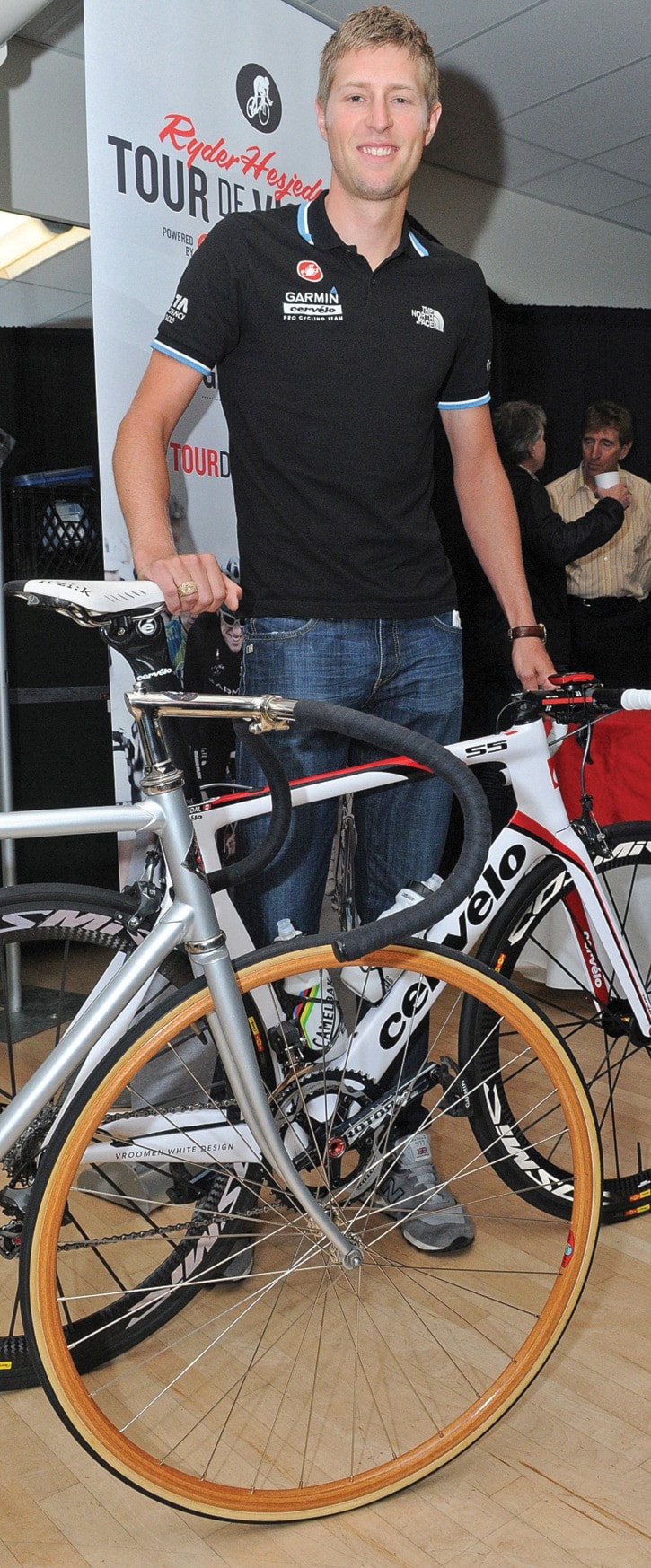If spokes could speak, Torchy Peden’s racing bike could tell some commanding stories.
William “Torchy” Peden’s track racing bicycle was the centre of attention on Saturday (May 12) as the Greater Victoria Sports Hall of Fame unveiled it as part of a permanent display in the concourse of Save-On-Foods Memorial Centre.
Even at 80-years-old, the frame of Peden’s single-speed bike shares a similarity to the highly sophisticated Cervelo road bike which Victoria’s Ryder Hesjedal raced to 18th at the 2011 Tour de France.
The two Canadian-made bikes now stand together as part of the hall’s new exhibit, a Cycling History of Greater Victoria: 1885-2012.
“It’s amazing what (Torchy’s) bike went through,” says Saanich-resident Mark Perkins, who inherited the Torchy track bike from dad Gordon Perkins.
At one point Torchy, who represented Canada in cycling at the 1928 Olympics, raced the bike in front of thousands of fans in the famous six-day races of the 1930s.
Mark’s dad got the bike in the early 1940s, and during the end of the war he used it to commute to work at the Victoria Machinery Depot.
“(Gord) used it during his courtship with my mom (Kay). She worked at the same place. He was a machinist and she was in the office. He would pick her up on the way and she’d ride side saddle, not an easy thing to do on a fixie.”
Kay didn’t seem to mind, as the pair married in 1947.
Gord likely raced the bike on the short lived Victoria Cycledrome, a wooden structure that showed up around 1940 at the Burnside Avenue and Douglas Street junction, but was gone by the early 1950s. Gord was born in 1923, 17 years after Torchy, and Gord became the B.C. road racing champ for his age group from 1935-38.
Torchy and his younger brother Doug may have shared the bike when they competed in the six-day races, which would fill New York’s Madison Square Garden.
It’s assumed the bike Gord inherited from Torchy once circled the track at MSG, for which it was designed. Coincidentally in the 1930s, both MSG and its winter tenant, the New York Rangers, were managed by Victoria’s Lester Patrick.
Mark Perkins points at a picture of five Victoria Cycling Club members training for the 1941 Vancouver Province bicycle road race by doing laps in the Victoria Cycledrome.
Among the cyclists are his dad, his dad’s friend Louis Haut and Eric Whitehead, who later documented many athletic achievements as a longtime sportswriter with the Vancouver Province.
Mark Perkins picks out his father and guesses, “I’d be surprised if that’s not the same bike he’s riding, as that’s about the time he got the bike.
“Dad rode the bike into his 70s, down around Clover and Ogden points by Beacon Hill Park, the same place he used to race in the 1930s.
Gord passed away in 2004, and Mark stored the bike in his garden shed.
“When I grew up it was in our basement in Cadboro Bay. With no brakes, it was a scary bike. As a teenager I rode it and crashed it at Ten Mile Point. My sisters rode it too, up and down the street.”
Vintage bike expert Casey Botman was tasked with restoring the bike in 2010 and finished it in 2011. Before it was enshrined at the Memorial Centre last weekend, it spent some time on display in the lobby the Peden RV Superstore in Sidney, run by the Peden generation of today.
“When (Botman) got the bike he noticed the frame was bent a little bit. I don’t know if that was from me crashing the bike as a teenager, but I know I replaced the wheel because of it,” Perkins said.
Botman, who lives in North Saanich, has a knack for bringing vintage bikes back to life, including the ultimate – penny farthings dating back to the 1890s. The significance of Torchy’s bike stood out.
“A lot of bikes come without a story. Torchy’s was a rare, but simple bike, definitely cool to restore because of its history.”
With the Greater Victoria Sports Hall of Fame’s financial backing, Botman began to order in replica parts from Europe, which are made to the original standards.
“The only thing CCM made was the crank and frame, but the bike would have had British-made hubs, and the other parts would have been made by different brands.”
Even without the common restoration challenges of antique bikes, such as coast brakes, hand brakes and gears, it took some luck to bring the Torchy bike back to original status.
One piece the hall of fame had already acquired was a leather Brooks seat, which had been engraved with a “T” for Torchy.
But the stem for the handlebars was the keystone to the whole operation. CCM used a Cinelli stem, made in Italy, and a physiotherapist in Sidney happened to have an original that was once part of a similar bike.
“We got lucky,” Perkins said.
The restoration
Both the frame and the forks of the Torchy Peden needed some work, but the bike is a shining homage to the days of dirt-road racing.
“In those days Torchy was on wood rims. There were steel rims but they were too heavy to race,” Botman said.
Replacing the wheels means ordering laminated beechwood replicas which are made in Italy.
“The replica decal on the rims and the Cinelli stem are very important,” Botman said.
sports@vicnews.com
